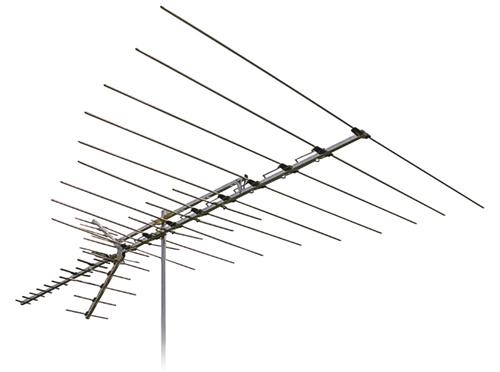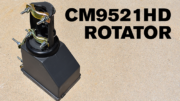As much as I hate to say it, not everyone sees the beauty in antennas. In fact I’d be willing to bet I’m one of the few people who does. Most people don’t have any desire to have their roof look like an antenna farm. It’s not a popular look among homeowners. As for apartment dwellers, you just may not have the space for all the antennas you want to have. That’s a problem. So, the question is, could you have one antenna that does it all? The answer’s a little more complicated than you would think.
Here’s why it’s hard
Antennas are different sizes and shapes because they need to pick up different signals. It’s only possible to have all those radio stations, TV stations, cell phone calls, Wi-Fi networks and on and on because there’s room on the “electromagnetic spectrum.” That’s the term we use for the sum total of all the radiation that comes at us. It’s a big place. It not only includes things like radio waves but also includes light, X-rays, and cosmic radiation.
The big difference between, for example, X-rays and FM radio signals, is the frequency. I don’t want to get into heavy duty physics here but one way to think about radiation is to think of it traveling in waves. You’ve seen charts like this one:

This is one way of looking at signals. They get stronger and weaker at predictable levels, at a particular number of times per second. FM radio waves seem pretty energetic, bobbing up and down at about 100 million times per second. That’s nothing compared to X-rays, which do the same dance at 10,000,000,000,000,000 times per second. If I’m counting right, that’s 10 quadrillion times per second. I don’t know about you, but I’m not really mentally capable of visualizing a quadrillion of anything. Point is, these signals have a lot of energy.
Another way of looking at these signals is that as the frequency gets higher, the distance between them is shorter. We call the distance between peaks the “wavelength” and that becomes important when you’re talking about antennas.
It’s all about wavelength really
Here’s how this affects you. You want your antenna to be about the same size as the wave it’s trying to catch. This means that, for example, you need an antenna about 12 feet wide if you really want to get the best signal on TV channel 7. On the other hand, to get a good signal from a satellite, you need an antenna about 1/3 of an inch wide. Luckily for people who like TV, you can also get a good signal with an even fraction of the wavelength. For example, you can use an antenna 3 feet wide or 6 feet wide to get channel 7 pretty well. Not as well as the 12 feet wide one but it’s still not bad.
This property of antennas is the reason why you end up needing different ones for everything you have. At least it’s one reason. There’s another one that’s a little easier to understand.
We ought to talk about signal strength
Here’s what you need to know: as you get further away from a broadcast, it gets weak, fast. How much weaker? There are formulas and all, but what you really need to know is that as you get further away you lose the ability to pick up a signal. Depending on how strong the signal was in the first place, that can be a problem.
Take these three examples. A radio station could broadcast at 100,000 watts from 80 miles away. It’s incredibly weak when it gets to you but with the right antenna you can get it. A cell tower may only be a mile away but it broadcasts at 5 watts. So it’s pretty weak when it gets to you as well. But neither of these signals is as weak as a satellite signal. A satellite is broadcasting its signal at a max of about 200 watts, from 22,000 miles away or more. That’s going to be one weak signal.
Here’s why you care about that. The FM signal is easy enough to pick up with a long wire. The cell signal is a little harder to deal with because no one wants a 3 foot tall antenna on their phone. So the antenna is designed to be small but focus as much signal as possible. The satellite signal is so weak that it needs a whole dish setup in order to gather as much of it as possible and put it in one place.
This makes the design of an antenna really important. It’s going to be different depending on what you want to receive.
One antenna for most
If you wanted to, you could have one antenna that picked up FM radio, UHF/VHF TV, and most cell signals. That’s because all of those signals are grouped in fairly closely. If your antenna is designed to pick up frequencies from 80-800 megahertz, you’d cover most of the signals used for those devices. TV signals actually go down to 54 megahertz. Cell signals can go as high as 25,000 megahertz but practically all of it is below 2,200 megahertz. Still, you could have an antenna like the one at the top of this article and it would get practically all you’d need. In fact this antenna is listed as picking up UHF, VHF, and FM signals already. Picking up cell signals would be a little harder but it’s not impossible.
In order to have one antenna that does it all, it would need to be pretty funky-looking, and it would also be pretty large. In the end it wouldn’t make anyone any happier.
Get the antenna you need today
There’s no point in holding out for some sort of amazing breakthrough that lets you use one tiny antenna for reception of everything you care about. It’s not going to happen. The laws of physics here are pretty clear and no matter how much tech you throw at them, that’s not going to change.
So, no matter what kind of antenna you need, it’s not worth waiting. Shop at Solid Signal for the best selection of tech from cellular to TV/radio to satellite and more. We have the best selection at the best prices! Even more importantly, we’re here to answer your questions! Call us at 888-233-7563 during East Coast business hours. We’ll give you all the help you need. If it’s after hours, fill out the form below. We’ll get back to you, usually within one business day.




